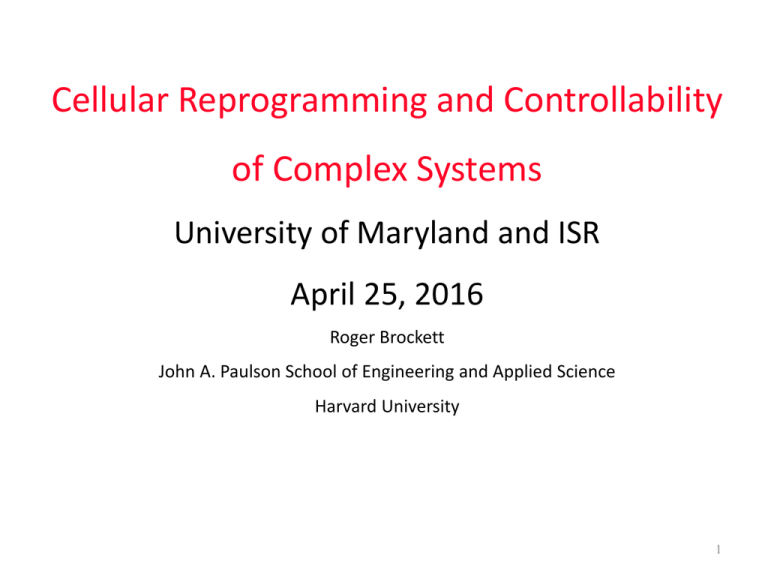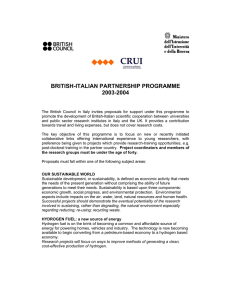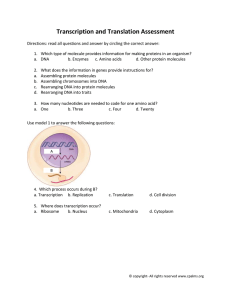Cellular Reprogramming and Controllability of Complex Systems University of Maryland and ISR
advertisement

Cellular Reprogramming and Controllability
of Complex Systems
University of Maryland and ISR
April 25, 2016
Roger Brockett
John A. Paulson School of Engineering and Applied Science
Harvard University
1
Metadata on the Talk
In this talk I will give a brief description of certain aspects of cell biology and
use these to define some problems related to the control of the fate of cells.
The centerpiece here is the problem of cellular reprogramming, e.g. steering a
group of skin cells so that they become skeletal muscle cells.
The Background: This talk is based on a ongoing, multi-person, experimental
and theoretical research effort centered at the University of Michigan, under
the leadership of Indika Rajapakse with DARPA sponsorship.
Expectations: I intend to sketch aspects of a specific “complex system” and
describe
some of the ways that are being used to influence the evolution an ensemble of
simpler units. I will put disproportionate emphasis on one or two questions which
can be reduced to a clean mathematical form. This is not meant to mislead but
rather to suggest to engineers that “Systems Biology” is not exclusively for others.
2
About the Talk
We first define the problem of cellular reprogramming and explain
how one might think of it in mathematical terms, including a suggestions
about ways to influence the evolution of cell type (control inputs).
After that we discuss periodicity as a central feature of cell dynamics and
introduce a class of mathematical models of the type that have been shown
to support oscillations. .
Given the large number of nonlinear processes involved, it is hardly surprising
that looking for simplified models suitable for capturing the features of
the system that will facilitate reprogramming leads in a different direction
from traditional model reduction and linear system identification.
3
Why reprogram a cell?
There are several compelling reasons for wanting to reprogram
a colony of cells. Two especially compelling ones are:
1. Cancer cells have been accidently reprogrammed by possible
exposure to a carcinogen or radiation or some other insult. A
possible path to recovery is to reprogram the cells, restoring
the cell line to a healthy state.
2. As a way to modify skin cells to create replacements for
damaged tissue by reprogramming the skin cells to prepare
them for a new role such as a role in muscle tissue.
Dealing with colonies, not individual cells
As in certain other areas that have recently become popular topics,
when control is applied to cell biology it usually involves controlling
populations, not individual cells. This kind of ensemble control
occurs in the control of swarms, quantum systems, demographics, etc.
Sometimes a stimulus is
applied to a mixed
colony of cells with the
goal of accentuating
the differences. Other
times the goal is to
create change in an
nearly homogenous
colony, accentuating
normal differences.
5
The Standard Picture of a Proliferating Cell Cycle
G2
M
G1
S
G1 phase. Metabolic changes prepare the cell for division. At a certain point - the
restriction point - the cell is committed to division and moves into the S phase.
S phase. DNA synthesis replicates the genetic material. Each chromosome now consists of
two sister chromatids.
G2 phase. Metabolic changes assemble the cytoplasmic materials necessary for mitosis and
cytokinesis.
M phase. A nuclear division (mitosis) followed by a cell division (cytokinesis).
Across species, the period of the cell cycle varies
but often it is on the order of 24 hours.
6
From the web
Mathematical Challenge: The cycle “repeats” but not
the way earth revolving about the sun does!
The process of moving around the cycle is first to prepare the cell for division by
processes involving generation of proteins, lipids, and genetic material and processes
related to the geometric reconfiguration of the internal elements. When division occurs
two daughter cells are generated. These may or may not be functionally different from
the mother and/or each other.
Nature orchestrates the processes involved so as to generate daughter cells of a desired
type. Determining the appropriate way to introduce steering (control) has been the
subject of study for several decades. The possibility of using quantitative system
identification techniques to gain more insight into how this can be done effectively and
efficiently is more recent.
8
Engineering analogy: under stress the electric power grid
may lose synchronization and break into islands
The initial conditions for the divided system come from
the pre breakup state of the original system. There does
not seem to be a general theory which predicts if and when
a breakup will occur. This seems to be a more complicated
version of the problem of computing the domain of
attraction. Perhaps this is an area in which interesting
developments can be expected in the near future.
9
Cell Types: From stem cells to differentiated cells
There are approximately 200 distinct cell types in the human
body. These include various types of skin cells, muscle cells,
nerve cells red blood cells, etc. In addition there are the
undifferentiated cells called stem cells. Of course all cells from
a particular person have the same DNA but the different cell types
make use of the DNA in different ways. Stem cells are said to be
pluripotent whereas the specialized cells are said to be
differentiated.
Importantly, all the cells in a particular animal have the same DNA.
The differences between the differentiated cells arise from
epigenetic factors such as differences in the way that the DNA is
folded or modified by attached proteins. More on epigenetics later.
10
A little vocabulary
DNA provides a cookbook but does not specify what is to be
cooked in a given situation.
A transcription factor (or DNA-binding factor) is a protein
that binds to specific DNA sites, thereby controlling the rate
of transcription of genetic information from DNA to
messenger RNA, ultimately, controlling the rate at which
specific proteins are created.
A possibly helpful analogy
DNA
=
cookbook
transcription factor (s) =
bookmark (s)
RNA
=
gathering the ingredients
protein production
= cooking and serving the result
protein degradation
=
cleaning up
Transcription can regulate protein production up or down.
11
The Waddington (1953) picture: Falling into a cell type
Stem cells
muscle cell
nerve cell
blood cell
In this picture, a cell type corresponds to a locally stable
equilibrium. Stem cells lie at the highest potential with
differentiated cells further “down the valley”.
12
Demonstrating that reprogramming is possible
Around 1990 H. Weintraub (L) successfully reprogrammed human
skin cells turning them into muscle cells via the over- expression of
one particular transcription factor, MyoD, thus becoming the first
to demonstrate that the natural course of cell development and
differentiation could be altered. In 2007, Yamanaka (R) et al.
changed the paradigm further by successfully reprogramming
human skin cells to embryonic-stem-cell-like state using the four
TFs {Oct4, Sox2, Klf4, Myc}, showing that the cell state could even
be pushed back to a pluripotent state [2].
13
How well can the process be understood?
The pioneering work was based on a deep understanding of
existing results and considerable trial and error, particularly in
the case of Yamanaka. In attempting to optimize the efficiency
of the reprogramming process it would be helpful to have a list
of the potentially useful control inputs and a quantitative model
of the system. However the system is complicated!
Quoting from: A Different Way of Doing Things
From The Scientist April 1, 2016
By Kivanç Birsoy and David M. Sabatini
“Cellular metabolism comprises an elaborate network of thousands of
biochemical reactions that allow a cell to grow, divide, and respond to its
environment. More than 100 years of research has identified some 3,000
enzymes and nutrient transporters, but only recently has it become clear
that cancer cells exploit these metabolic components to support their own
proliferation and survival.”
One example
of complexity
Data for modeling the inner workings of cells
There are a growing number of ways to probe cells so as to learn
more about the dynamical relationships that they utilize. One
dominant feature is the presence of nearly periodic trajectories.
For the most part these have periods of about 24 hours. By
modeling and then measuring these one can hope to better
evaluate the gains and time constants of various components.
Another way is to refine models is to measure the steady state
change in the state that is generated by a constant input. Such
experiments can provide some quantitative information about
cell dynamics, even though the in is a steady state
measurement.
Organization based on Oscillations
Quoting from: A circadian gene expression atlas in mammals: ….
Ray Zhang et al. PNAS, 2014.
“We generated high-resolution multi-organ expression data showing
that nearly half of all genes in the mouse genome oscillate with
circadian rhythm somewhere in the body. Such widespread
transcriptional oscillations have not been previously reported in
mammals. Applying pathway analysis, we observed new clockmediated spatiotemporal relationships. Moreover, we found a
majority of best-selling drugs in the United States target circadian
gene products. Many of these drugs have relatively short half-lives,
and our data predict which may benefit from timed dosing.”
Oscillations and synchronization
As noted, there are thousands of individual processes involved in
the maintenance and growth of individual cells. Some of these
processes can be described as ordinary chemical reactions while
others involve transcription and thus differ from the reactions
taught in high school chemistry. These processes must be
sequenced appropriately in normal operation. An important part
of the mechanisms for doing this are the various biological
oscillators existing it the cell. Many details about how they work
together remain unknown but most operate with a period of
about 24 hours. These are not simply the response to an external
periodic input but are self sustained but with the ability to adjust
so as to synchronize with the circadian oscillation.
18
Oscillations involving gene expression
second order
but more like
heat flow
equations
The (simplified) repressilator model
20
One solution of the repressilator equations
Oscillations are not well approximated by sine waves so
harmonic balance is not effective and phase is undefined.
Data from Rajapakse lab
This data is from a colony of cells which were initialized at t=0. As
22
time goes on they become less well synchronized so smoothing occurs.
A mathematical/statistical challenge
Give the data graphed in the previous slide, suggest a
parametrized model describing the loss of synchronization
and use it to find the maximum likelihood fit the the
parameters of the oscillator.
23
A more general version of Elowitz-Leibler
24
Synchronization with an external stimulus
A lot more could be said about the tree-like structure of
the clock networks of plants and animals reported in the
literature. (suprachiasmatic nucleus in humans, etc.)
25
Synchronization with an external stimulus
external
signal
Showing how an oscillator
having a natural frequency
of about 1.35 locks in with
an external signal of
frequency 1. In one interpretation, beta would be
the concentration of a
catalyst and the equation
for its derivative derived
from chemical kinetics.
26
Data from steady state relationships
27
Possible Measurements
How to adapt this to the situation where
steady state is an oscillation?
28
More detailed data based modeling
29
Data guided controllability for reprogramming
A short segment of DNA
Data guided Controllability:
Learning from the
Human Genome, Geoff
Patterson, et al. (Submitted)
Data guided controllability for reprogramming
various domains of attraction as
suggested by Waddington
31
Results, glossing over many many details
Data guided Controllability: Learning from the
Human Genome, Geoff Patterson, et al. (Submitted)
32



